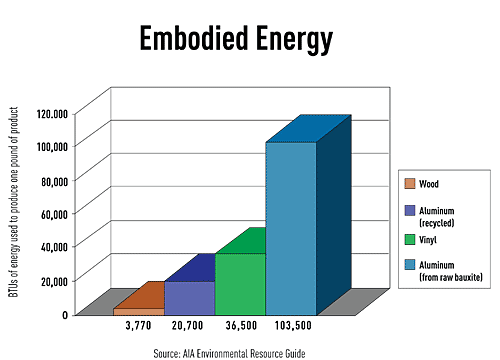Windows and Sustainability: An Environmental Perspective
According to AIA's Environmental Resource Guide, wood requires 3,770 British thermal units (BTU) per pound (BTU/lb); recycled aluminum needs 20,700 BTU/lb, vinyl consumes 36,500 BTU/lb, and aluminum uses 103,500 BTU/lb from raw bauxite. Approximately 27.5 percent of total aluminum production comes from recycled aluminum.
In a study from the UK, "Life Cycle Analysis of Window Materials - A Comparative Analysis," (Napier University School of Engineering, Edinburgh, 2002) an embodied energy analysis of standard windows concluded that aluminum windows used the most embodied energy, while PVC required about three times as much embodied energy as wood. The study stated that aluminum and wood windows typically last over 40 years, while PVC has an optimum life of 25 years.
Pollution Produced During Manufacturing: Energy use results in pollution. Assuming the same type of energy is used to manufacture aluminum, vinyl, and wood window frames, varying amounts of pollution are typically generated. According to a 1993 preliminary air and water emissions study by the Western Woods Products Association, wood windows produced far less pollution than aluminum. Air emissions from aluminum were eight times higher than for wood. Water emissions from aluminum were 300 times higher than for wood. Carbon dioxide (CO2) emissions from aluminum were 26 times higher than for wood, and from vinyl were 11 times higher than for wood.
|
||
The aforementioned UK study, "Life Cycle Analysis of Window Materials," concluded that aluminum window frames cause the highest environmental impact because of dangerous pollutants released and high energy consumption during production. PVC contributes large amounts of poisonous pollutants throughout its life cycle, while wood window frames have the fewest environmental burdens.
Energy Consumed: The impact of different window frame materials on overall energy costs can be evaluated by using a prototypical condominium project in three different U.S. climate zones. Thermal performance characteristics of wood and vinyl windows are presumed to be the same. Based on data and case studies from the Efficient Windows Collaborative (www.efficientwindows.org), descriptions, U-values, and Solar Heat Gain Coefficients (SHGCs) are consistent for this comparison, using low-E clear double glass that is spectrally selective. SHGC measures how well a window stops the transmission of solar heat gain in a building. Lower numbers mean less solar heat gain. U-values and SHGCs are for the total window and frame.
Using the same glass, this analysis compares different window frame materials, aluminum frame with thermal break, aluminum-clad wood frame, and vinyl frame, for energy performance. Results may vary depending on specifications.










